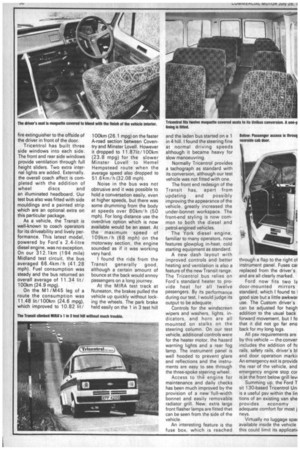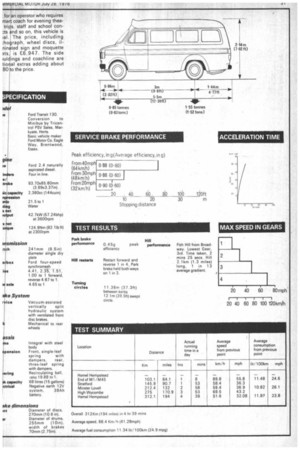onverted Transit r outings in style
Page 31

Page 32

Page 33

If you've noticed an error in this article please click here to report it so we can fix it.
oel Milner test drives Tricentrors conversion
N4 coach operators ine in their fleets at least tvVelve-seater coach and e Operate nothing but. It ften a problem to cost Iv-seater hire as their r nning costs are often th t much less than those III sized coaches.
n e a demand for a twelverI is established, the next lm is to decide whether to van conversion or a osi e-built twelve-seater. For I economic reasons, the nversion is often chosen firm favourite as a basis 3 psv is the Ford Transit
ong examples of twelver conversions is TricenUnibus, based on the latxample of the long-wheelTransit. The subject of my t road test was one of the conversions of the new isit range introduced in
..:h.
he overall impression of the Sit was pleasing and one of a complete purpose-designed vehicle rather than a conversion. The basic van was the Custom version of the Transit 130. The optional custom pack provides externally raised rubber bumper inserts front and rear, intermittent windscreen wiper and rectangular halogen headlamps. Internally such features as a cigar lighter, stowage bin on driver's door and woodgrain facia strip are added. Tricentrol extends the custom effect by fitting a flat vinylcovered hardboard floor with, on our test vehicle, twelve moquette-covered seats. To help the complete vehicle impression, a moquette driver's seat cover is added.
The interior sides and the back doors are fitted with a wood grained formica-type material. A contrasting material is fitted to the window sur rounds, and ash trays are fitted in the side panelling beside every seat.
The passenger entrance is through the nearside door and the flat floor has been fitted to join with the main entrance step. The original Ford black rubber mat is fitted forward at the front edge of the front entrance step and in the driving area. A first aid box is provided in the glove compartment, and a fire extinguisher to the offside of the driver in front of the door.
Tricentrol has built three side windows into each side. The front and rear side windows provide ventilation through full height sliders. Two extra internal lights are added. Externally, the overall coach affect is completed with the addition of wheel discs and an illuminated headboard. Our test bus also was fitted with side mouldings and a painted strip which are an optional extra on this particular package.
As a vehicle, the Transit is well-known to coach operators for its driveability and lively performance. This latest model, powered by Ford's 2.4-litre diesel engine, was no exception. On our 312.1krn (194 mile) Midland test circuit, the bus. averaged 66.4km /h (41.28 mph). Fuel consumption was steady and the bus returned an overall average of 11.34 lit / 100km (24.9 mpg).
On the M1 /M45 leg of a route the consumption was 11.48 lit/100km (24,6 mpg), which improved to 10.82 lit / 100km (26.1 mpg) on the faster A-road section between Coventry and Minster Lovell. However it dropped to 11.87Iit / 100km (23.8 mpg) for the slower Minster Lovell to Hemel Hempstead route when the average speed also dropped to 51.6 km/h (32.08 mph).
Noise in the bus was not obtrusive and it was possible to hold a conversation easily, even at higher speeds, but there was some drumming from the body at speeds over 80km/ h (50 mph). For long distance use the overdrive option which is now available would be an asset. At the maximum speed of 109km /h (68 mph) on the motorway section, the engine sounded as if it was working very hard.
found the ride from the Transit generally good, although a certain amount of bounce at the back would annoy passengers on a long journey.
At the MIRA test track at Nuneaton, the brakes pulled the vehicle up quickly without locking the wheels. The park brake held easily on the 1 in 3 test hill
and the laden bus started on a 1 in 4 hill. I found the steering fine at normal driving speeds although it became heavy for slow manoeuvring.
Normally Tricentrol provides a tachograph as standard with its conversion, although our test vehicle was not fitted with one.
The front end redesign of the Transit has, apart from updating an d possibly improving the appearance of the vehicle, greatly increased the under-bonnet workspace. The front-end styling is now common to both the diesel and petrol-engined vehicles.
The York diesel engine, familiar to many operators, now features glowplug in-heat, cold starting equipment as standard.
A new dash layout with improved controls and better heating and ventilation is also a feature of the new Transit range. The Tricentrol bus relies on Ford's standard heater to provide heat for all twelve passengers. By its performance during our test, I would judge its output to be adequate.
Controls for the windscreen wipers and washers, lights, indicators, and horn are all mounted on stalks on the steering column. On our test vehicle, additional controls were for the heater motor, the hazard warning lights and a rear fog lamp. The instrument panel is well hooded to prevent glare and reflections and the instruments are easy to see through the three-spoke steering wheel.
Access to the engine for maintenance and daily checks has been much improved by the provision of a new full-width bonnet and easily removable radiator grill. New, extra large front flasher lamps are fitted that can be seen from the side of the vehicle.
An interesting feature is the fuse box, which is reached through a flap to the right of instrument panel. Fuses car replaced from the driver's and are all clearly marked.
Ford now fits two door-mounted mirrors standard, which I found to I good size but a little awkwar use. The Custom driver's can be adjusted for heigh addition to the usual back forward movement, but I fo that it did not go far eno back for my long legs.
All psv requirements are by this vehicle — the conver includes the addition of hi rails, safety rails, driver's 131 and door operation markir An emergency exit is provide the rear of the vehicle, and emergency engine stop cor is at the front below grill levi Summing up, the Ford T sit 130-based Tricentrol Un is a useful psv within the in tions of an existing van she provides economy adequate comfort for most j neys.
Virtually no luggage spa( available inside the vehicle this could limit its applicatil
. for an operator who requires mart coach for evening theatrips, staff and school con:ts and so on, this vehicle is :al. The price, including :hograph, wheel discs, ilninated sign and moquette its, is £6,947. The side iuldings and coachline are tional extras adding about BO to the price.




























































































